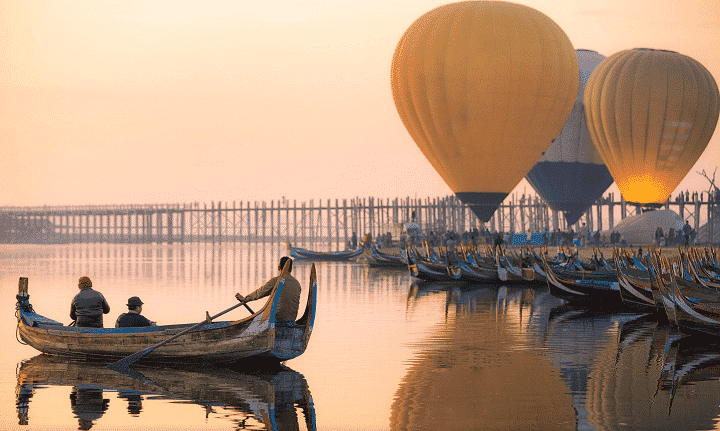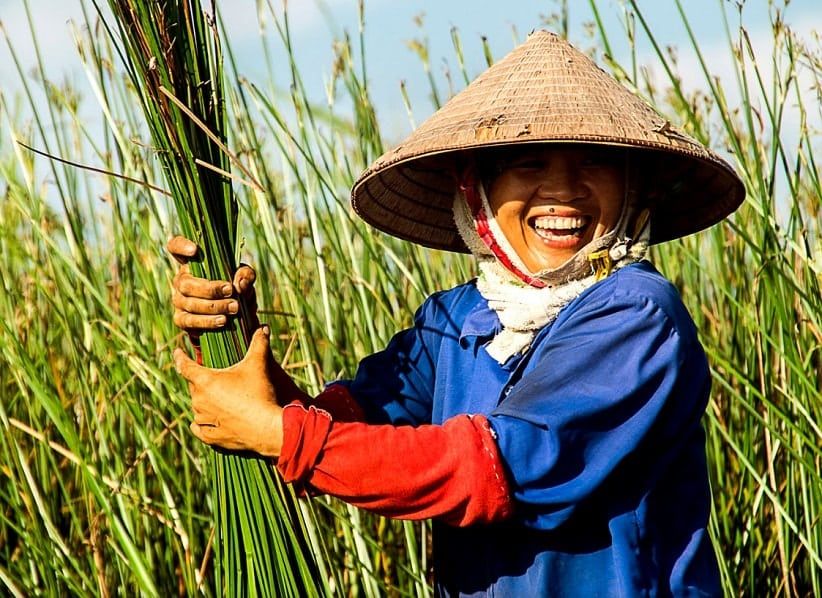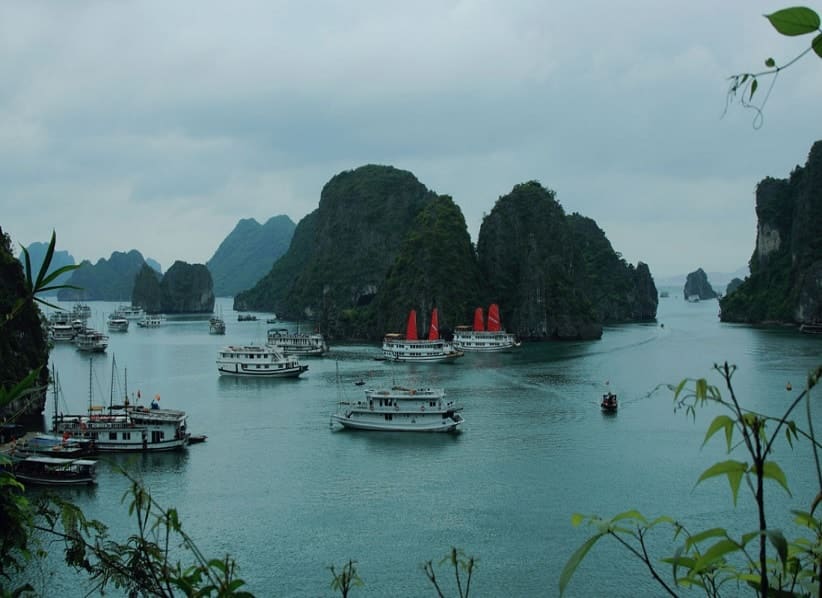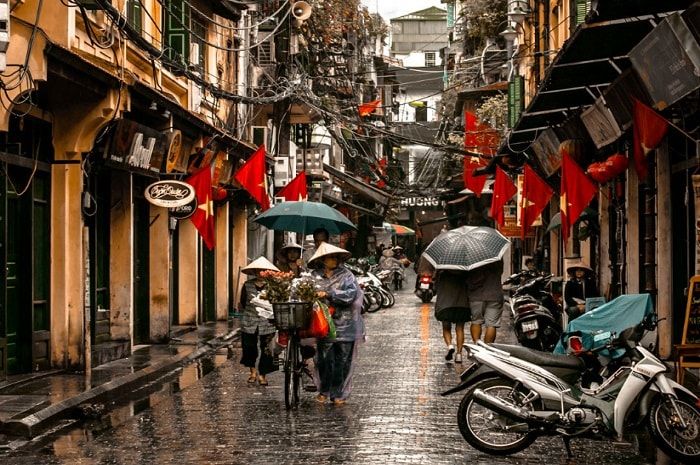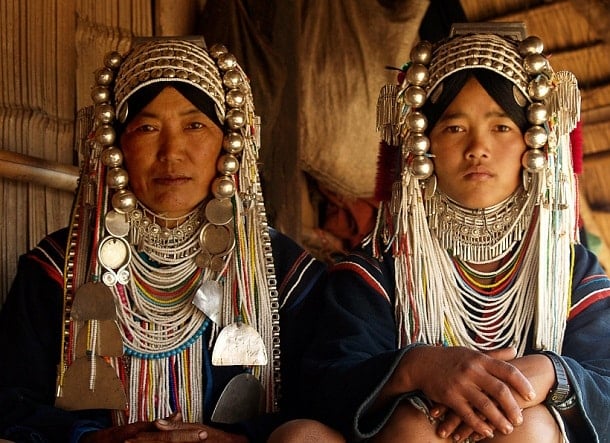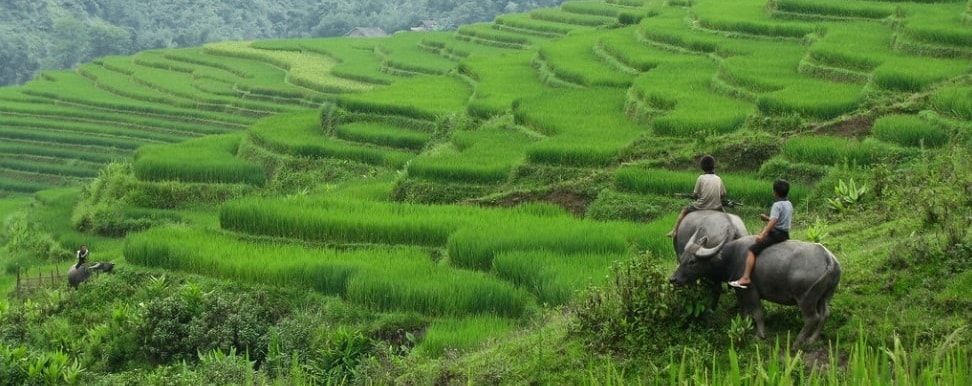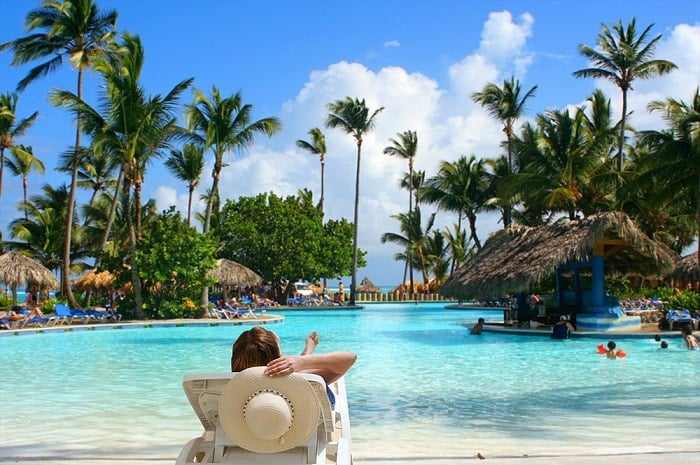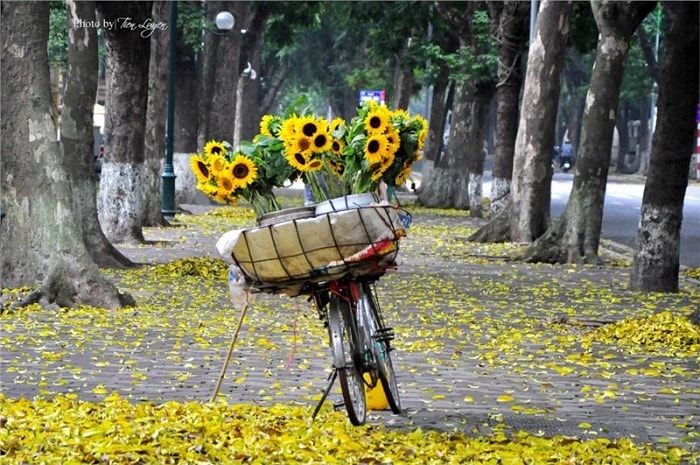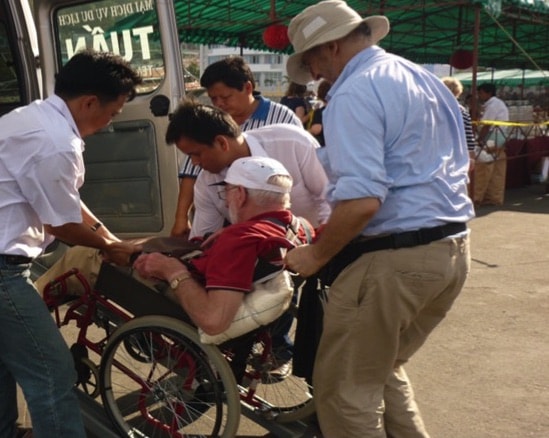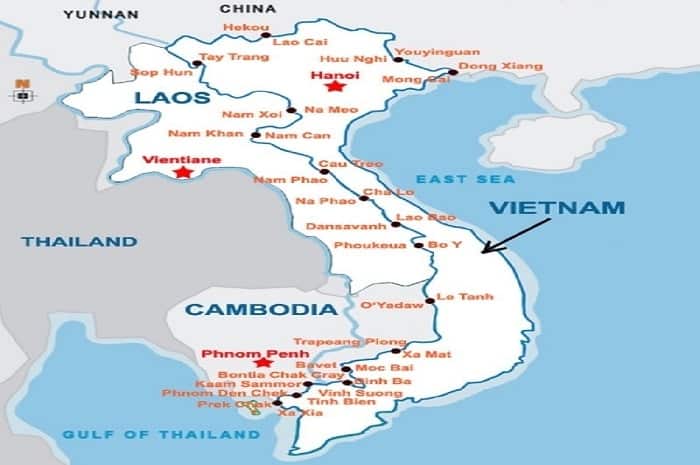VIETNAM TRAVEL TIPS 2024
Looking for the best Vietnam travel tips ? the country reveals hauntingly beautiful and blesses with a rich heritage, fascinating cities and charming people, Vietnam is a beguiling destination for traveling. Hanoi’s understated charm is almost impossible to resist from its elegant avenues and gold-stone mansions of the colonial city to the maze of bustling streets lined with traders in the Old Quarter. Heading south, the imperial palaces of Hue contrast sharply with the nearby battlefields and secret tunnels of the Vietnam War, while the delightful Chinese shop-houses and silk traders of Hoi An seem almost lost in time in comparison with the frenetic pace of Saigon. While Communism has been firmly replaced by a tiger economy, the French influence remains in the exquisite architecture and the baguettes for sale at roadside stalls. Vietnam has far more to offer than just its cities however, with a rich cultural diversity and incredible natural beauty. From the towering limestone peaks jutting dramatically out of the water in Halong bay to the lush fields of the Mekong Delta, the country’s majestic scenery, deserted beaches and jungle-clad peaks are just begging to be explored.
Quick Travel Guide & Facts
Full country name: Socialist Republic of Vietnam
Area: 329,566 sq km
Population: 96 million (2019)
Capital City: Hanoi (pop 8 million)
People: 84% ethnic Vietnamese, 2% ethnic Chinese, also Khmers, Chams (a remnant of the once-great Indianised Champa Kingdom) and members of over 50 ethno linguistic groups.
Language: Vietnamese
Religion: Buddhism is the principal religion but there are also sizeable Taoist, Confucian, Hoa Hao, Caodaists, Muslim and Christian minorities
Time Zone: GMT/UTC +7
Dialing Code: 84
Electricity: 220V ,50Hz
Weights & measures: Metric
When is the best time to travel?
There are no good or bad seasons to travel to Vietnam. When one region is wet, cold or steamy hot, there is always somewhere else that is sunny and pleasant. Basically, the south has two seasons: the wet (May to November, wettest from June to August) and the dry (December to April). The hottest and most humid time is from the end of February to May. The central coast is dry from May to October and wet from December to February. The highland areas are significantly cooler than the lowlands, and temperatures can get down to freezing in winter. The north has two seasons: cool, damp winters (November to April) and hot summers (May to October). There is the possibility of typhoons between July and November, affecting the north and central areas.
Travelers should take the Vietnam Tet New Year festival (late January or early February) into account when planning a trip. Travel (including international travel) becomes very difficult, hotels are full and many services close down for at least a week and possibly a lot longer. However, that can be a hassle-free travel if you book your trip well in a head of time.
Vietnam Travel Planning: Things to know
Money
The first currency of Vietnam is the Vietnamese dong, which is abbreviated to ‘d’. Banknotes come in denominations of 500d, 1000d, 2000d, 5000d, 10,000d, 20,000d, 50,000d, 100,000d, 200,000d and 500,000d with pictures of Ho Chi Minh on every banknote. The second currency is the US dollar and that needs no introduction.
Vietnamese dong has experienced its ups and downs. Where prices on the ground are quoted in dong, we quote them in this book in dong. Likewise, when prices are quoted in dollars, we follow suit. While this may seem inconsistent, this is the way it’s done in Vietnam and the sooner you get used to thinking comparatively in dong and dollars, the easier your travels will be. Anyway, nobody ask you to pay in US$, so, have your dollars changed to VND and travel easy. ATM’s are everywhere and you can get local currency withdraw, however, remember to bring cash if you travel to remote areas in Vietnam. Travellers Cheques, well, It is wise not to rely entirely on travellers cheques by keeping a reasonable stash of US dollars to hand. Travellers cheques can only be exchanged at authorized foreign-exchange. If your travellers cheques are in currencies other than US dollars, they may be useless beyond the major cities. Hefty commissions are the norm if they can be exchanged at all.
Transportation and domestic flights
Domestic flights are quite good value for longer journeys, particularly with lowcost carrier Vietjet, Jetstar Pacific and then the national carrier, Vietnam Airlines on the scene. A one-way ticket from Hanoi to HCMC is around US$100, although Vietjet can be cheaper. Trains are great value and overnight sleepers are a good way to cover long distances like Hanoi to Hue or HCMC to Nha Trang.
Vietnam Travel Tips: Bus traveling in Vienam is a bargain by Western standards, as long as you manage to pay the local price. Public buses between major destinations have fixed fares, but for bus travel in remote areas, overcharging is the rule. For maximum flexibility, many travellers prefer to rent a car or 4WD and go exploring with a guide. Costs run from about US$40 around town to US$100 or more a day up-country (including the driver’s food and lodging). A guide costs from US$30 per day, depending on the destination.
Insider tips for visas: Tourist visas allow visitors to enter and exit Vietnam at Hanoi, HCMC and Danang airports as well as any of Vietnam’s plentiful land borders, shared with Cambodia, China and Laos. If you crossing the land borders, you’ll need a visa beforehand. Read full article on How to get a visa for Vietnam
Cost of traveling in Vietnam
The cost of travel in Vietnam varies from bargain basement to sky high, depending on taste and comfort. Ascetics could just about get by on US$30 a day, while a conventional budget traveller can live it up from US$55 to US$65. Midrange travellers can have a ball from US$80 to US$100 a day, staying comfortably, eating well and travelling flexibly. At the top end, spending US$250 or more a day, anything is possible. Vietnam is not quite as cheap as it used to be back in the day thanks to rampant inflation, but it is still a great deal compared with many parts of the world. Many vacation makers still call Vietnam a cheap destination to travel. We, however, agreed on this.
In tourist centres, most hotels will accept both US$ and VND, while other businesses may prefer dong. As you venture off the trail, make sure you are packing plenty of local currency. Rooms start from as little as US$10 in busy tourist centres. Spending US$10 to US$30 will boost the comforts quickly, and rooms will generally include air-con, satellite TV, fridge and hot water. Make the step up to US$50 and three-star frills are available. At US$100 and above, it’s five-star territory in many destinations, although Hanoi and Ho Chi Minh City (HCMC) tend to be more expensive than the provinces. Don’t be afraid to negotiate for a discount if it is low season or if numbers are down.
Dining out is where Vietnam comes into its own. Surfing the street stalls and markets, meals can be found for 25000 VND or a bit higher. Local restaurants are more comfortable and you can eat well for between 50000 to 100000 VND. Then there are the Vietnamese gourmet restaurants, where you can still only spend around 120000 with drinks; with the right wines you could easily spend 700000 VND and more.
Foreigners are sometimes overcharged, particularly when buying souvenirs and occasionally in restaurants. Transport prices are sometimes bumped up to several times the Vietnamese price. However, don’t assume that everyone is trying to rip you off. This is a big NO, make your way and compare the prices and remember you pay the final orice based on your negotiating skill. Despite widespread poverty, many Vietnamese will only ask the local price for many goods and services.
What to Pack?
Pack medications in their original, clearly labelled, containers. A signed and dated letter from your physician describing your medical conditions and medications, including generic names, is also a good idea. If carrying syringes or needles, be sure to have a physician’s letter documenting their medical necessity. If you have a heart condition bring a copy of your ECG taken just prior to travelling.
Vietnam Travel Tips: If you happen to take any regular medication bring double your needs in case of loss or theft. In most Southeast Asian countries you can buy many medications over the counter without a doctor’s prescription, but it can be difficult to find some of the newer drugs, particularly the latest antidepressant drugs, blood pressure medications and contraceptive pills.
Insurance
Even if you are fit and healthy, don’t travel without health insurance – accidents do happen. Declare any existing medical conditions you have – the insurance company will check if your problem is pre-existing and will not cover you if it is undeclared. You may require extra cover for adventure activities such as rock climbing. If your health insurance doesn’t cover you for medical expenses abroad, consider getting extra insurance. If you’re uninsured, emergency evacuation is expensive; bills of over US$100 are not uncommon. You should find out in advance if your insurance plan will make payments directly to providers or if they reimburse you later for overseas health expenditures. (Note that in many countries doctors expect payment in cash.) Some policies offer lower and higher medical-expense options; the higher ones are chiefly for countries that have extremely high medical costs, such as the USA.
You may prefer a policy that pays doctors or hospitals directly rather than you having to pay on the spot and claim later. If you have to claim later, make sure you keep all documentation. Some policies ask you to call back (reverse charges) to a centre in your home country where an immediate assessment of your problem is made.
Vaccinations
The only vaccine required by international regulations is yellow fever. Proof of vaccination will only be required if you have visited a country in the yellow-fever zone within the six days prior to entering Vietnam. If you are travelling to Vietnam from Africa or South America you should check to see if you require proof of vaccination. Specialised travel-medicine clinics are your best source of information; they stock all available vaccines and will be able to give specific recommendations for you and your trip. The doctors will take into account factors such as past vaccination history, the length of your trip, activities you may be undertaking, and underlying medical conditions, such as pregnancy.
Most vaccines don’t produce immunity until at least two weeks after they’re given, so visit a doctor four to eight weeks before departure. Ask your doctor for an International Certificate of Vaccination (otherwise known as the yellow booklet), which will list all the vaccinations you’ve received. In the US, the yellow booklet is no longer issued, but it is highly unlikely the Vietnam authorities will ask for proof of vaccinations (unless you have recently been in a yellow-fever affected country).
Medical checklist
Antibacterial cream, eg Muciprocin
Antibiotics for skin infections, eg Amoxicillin/Clavulanate or Cephalexin
Antibiotics for diarrhoea, eg Norfloxacin or Ciprofloxacin; Azithromycin for bacterial diarrhoea; and Tinidazole for giardiasis or amoebic dysentery
Antifungal cream, eg Clotrimazole
Antihistamines for allergies, eg Cetrizine for daytime and Promethazine for night
Anti-inflammatories, eg Ibuprofen
Antinausea medication, eg Prochlorperazine
Antiseptic for cuts and scrapes, eg Betadine
Antispasmodic for stomach cramps, eg Buscopa
Contraceptives
Decongestant for colds and flus, eg Pseudoephedrine
DEET-based insect repellent
Diarrhoea ‘stopper’, eg Loperamide
First-aid items such as scissors, plasters (Band Aids), bandages, gauze, thermometer (electronic, not mercury), sterile needles and syringes, safety pins and tweezers
Indigestion medication, eg Quick Eze or Mylanta
Iodine tablets (unless you are pregnant or have a thyroid problem) to purify water laxatives, eg Coloxyl
Migraine medication (your personal brand), if a migraine sufferer
Oral-rehydration solution for diarrhoea, eg Gastrolyte
Paracetamol for pain
Permethrin (to impregnate clothing and mosquito nets) for repelling insects
Steroid cream for allergic/itchy rashes, eg 1% to 2% hydrocortisone
Sunscreen and hat
Throat lozenges
Thrush (vaginal yeast infection) treatment, eg Clotrimazole pessaries or Diflucan tablet
Urrine alkalisation agent, eg Ural, if you’re prone to urinary tract infections.
Advice for Long-term travelers to Vietnam
These vaccinations are recommended for people travelling more than one month, or those at special risk:
Japanese B Encephalitis – three injections in all. A booster is recommended after two years. A sore arm and headache are the most common side effects reported. Rarely, an allergic reaction comprising hives and swelling can occur up to 10 days after any of the three doses.
Meningitis – single injection. There are two types of vaccination: the quadrivalent vaccine gives two to three years protection; meningitis group C vaccine gives around 10 years protection.
Recommended for long-term travellers aged under 25.
Rabies – three injections in all. A booster after one year will provide 10 years of protection. Side effects are rare – occasionally a headache and sore arm.
Tuberculosis – adult long-term travellers are usually recommended to have a TB skin test before and after travel, rather than vaccination. Note that only one vaccine is given in a lifetime.
Is Vietnam safe to visit?
Dangers & annoyances, Scams and Con artists and thieves are generally never appearing on your way, Vietnam is a very safe country to travel. Just pay attention when you rent a bike, check the motorbike and be agree on the only contract for whatever day or month are you going to rent a motorbike. Despite an array of scams that may exist, however, it is important to keep in mind the Vietnamese are not always out to get you. One concerning trend we’re noticing in Vietnam, relative to neighbouring countries such as Cambodia and Laos, is a general lack of trust in the locals on the part of foreigners. Try to differentiate between who is good and bad and do not close yourself off to every person you encounter.
Ho Chi Minh City is the place to really keep your wits about you. Don’t have anything dangling from your body that you are not ready to part with, including bags and jewellery, which might tempt a robber. Keep an eye out for drive-by thieves on motorbikes – they specialise in snatching handbags and cameras from tourists on foot and taking cyclos in the city. Despite all this, don’t be overly paranoid. Although crime certainly exists and you need to be aware of it, theft in Vietnam does not seem to be any worse than what you’d expect anywhere else. Don’t assume that everyone’s a thief – most Vietnamese are poor, but honest and I am 100% sure you will love how safe Vietnam is. Enjoy it.
Best things to do in Vietnam
Vietnam Travel Tips: Traveling to Vietnam is anyone’s dream with so much to see and to do. The country has earned the top positions of the most visited destination in Southeast Asia. It is not for less, there is much to see in Vietnam and that is already an open secret. From infinite rice paddies to paradisiacal beaches, through one of the most beautiful natural landscapes in the world, Ha-Long Bay, a trip to Vietnam promises millions of emotions, keep in mind that Vietnamese cuisine is, without any discussion, one of the richest and most varied in the region. Keep reading and select what to see in Vietnam with the clues we give you below.
Discover the chaotic capital, Hanoi
Despite being the capital of modern Vietnam, Hanoi moves at a gentle pace. Alluringly set on the Red River, parts of the city have the atmosphere of a provincial town, but for bicycling schoolgirls wearing traditional white áo dàis (a fitted silk tunic over loose trousers) and wispy- bearded men in pith helmets. We use central hotels, putting you within walking distance of the 36 narrow streets of the Old Quarter, the relaxed cafes around Hoan Kiem Lake and the tree-lined boulevards of the colonial French Quarter. Some best deal Vietnam travel package and a city tour might visit Ho Chi Minh’s imposing mausoleum, the Museum of Ethnology with its vivid illustration of the country’s many minority tribes or you could have a private lesson on the art of water puppetry. Many of Hanoi’s greatest sights are smaller and you’ll find them at every turn: temples and pagodas clustered around the Old Quarter and wedding photographers at work in the city parks.

Dive your way to Nha Trang
Until recently, Nha Trang was best known to the Vietnamese as one of the country’s biggest fishing ports but its pristine waters and long sandy beaches attract visitors from further afield. Some of the town has succumbed to overdevelopment however, and so we recommend staying at one of the coast’s secluded beach options, such as the beautiful Six Senses Ninh Van Bay or the luxury beach sanctuary in Nui Chua National Park, the Amanoi.

Halong Bay: of the most magical places in the world
Thousands of sheer limestone pillars jut out of the dark, emerald waters of Halong Bay. A designated UNESCO World Heritage Site, the islands are one of Asia’s most iconic landscapes. Equally atmospheric whether bathed in sunshine or shrouded in mist, a cruise on the calm waters here allows for dramatic photographic opportunities. You will also see a glimpse of typical Vietnamese life, with families reliant on fishing for their livelihood waving from their floating homes. Due to its obvious appeal, Halong Bay cruise tours is one of the most do activities in Vietnam but it is possible to avoid the crowds by carefully choosing your cruise option. For a unique view of Halong Bay, it is possible to take a scenic flight by seaplane which departs from Hanoi and lands directly in the bay.
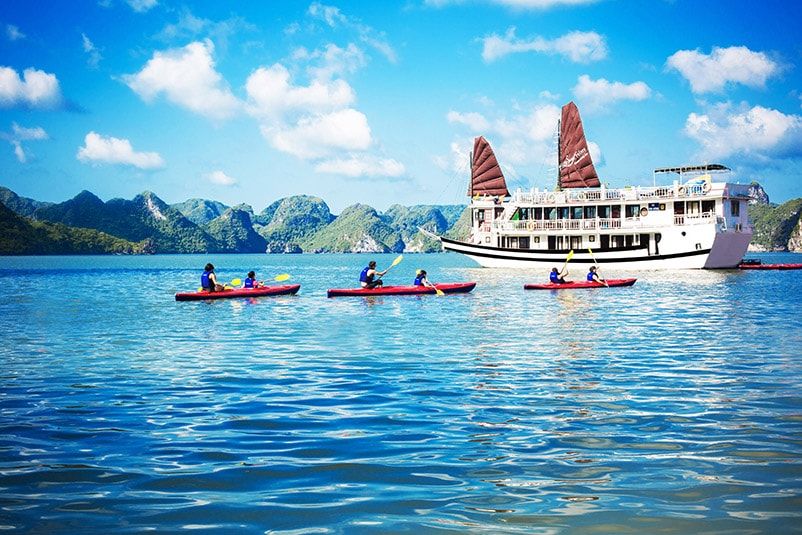
Sapa and the Tonkinese alps
The small French hill station of Sapa nestles among the stunning scenery of the Tonkinese Alps. Easy day walks pass through terraced paddy fields to reach H’mong and Dao minority villages, where traditional dress is still worn and ancient beliefs hold sway. There are a number of trains that run from Hanoi to Lao Cai, the transit town for Sapa. Currently the most comfortable option is the Victoria Express, with two or four berth cabins that, while not en suite, provide comfortable facilities for the journey. For those wishing to travel overland from Sapa to Hanoi, it is well worth taking the time to visit the magnificent rice paddies at Mu Cang Chai, particularly in September and October, when the rice is harvested.
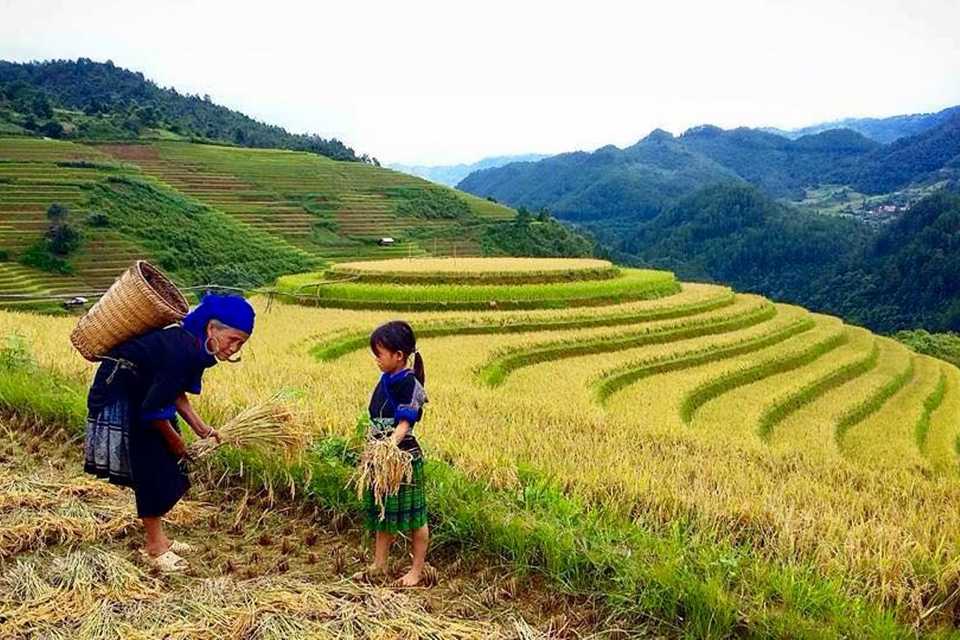
Beautiful Hoi An & around
Prior to the arrival of the French, Hoi An was Vietnam’s window on the world. Tucked away amongst the backstreets are the houses of merchants from Asia and Europe, lured from afar by the prospect of high grade silk and porcelain. It is an ideal spot to stop for a few days to just soak up the atmosphere, stroll along the wharf, shop in the market or be measured up for a silk dress or suit by one of the many fine tailors who trade here. There are many restaurants, old houses, craft shops and art galleries, where local artists exhibit their works. The bustling market is an assault on the senses and a fantastic place to sample a steaming bowl of cau lau, a dish of noodles, pork and greens and a local speciality.
Away from Hoi An’s historic heart there is still much to explore. Cua Dai beach is just three kilometres from the town, and the route offers a pleasant cycle ride through paddy fields and along the riverbank. There are a number of good beach resorts here. For a real sample of rural Vietnamese life, spend a morning working with local farmers to learn the art of rice cultivation. You can assist with the transplanting of rice seedlings, harvesting crops by hand and grinding the rice to make rice milk, as well as seeing the paddy fields ploughed by water buffaloes in the traditional way. Another popular trip is to go to the mouth of the Hoi An River where it reaches the South China Sea. Here you will board a traditional basket boat to try your hand at fishing. Back on dry land, spend time with a local fishing community, learning a little about the lives of the families that live here – mending nets, maintaining boats and preparing the catch of the day for market. As a day trip from Hoi An, you can visit Vietnam’s grandest Cham ruins at My Son.

Ho Chi Minh City [Saigon]
This vibrant city was the original ‘Pearl of the Orient’ and along the old Rue Catinat and in the surrounding boulevards stand relics of empire and revolution: Notre Dame Cathedral, the Post Office and the Opera House. The city continues to undergo rapid change with new skyscrapers altering the skyline, lively bars and a booming economy all under the watchful gaze of ‘Uncle Ho’, whose statue stands outside the old Hotel de Ville. There is still plenty of local charm: soup sellers ring their chimes to signify a freshly made lunch, fortune-tellers read palms and incense drifts from busy temples. The choice of restaurants is outstanding and there are plenty of opportunities for shopping. One of the best ways to explore is on a Vespa tour, taking in the authentic outer districts by night and sampling local food. Nearby are the infamous Cu Chi Tunnels, a network of secret underground passages used by the Vietcong during the Vietnam War.
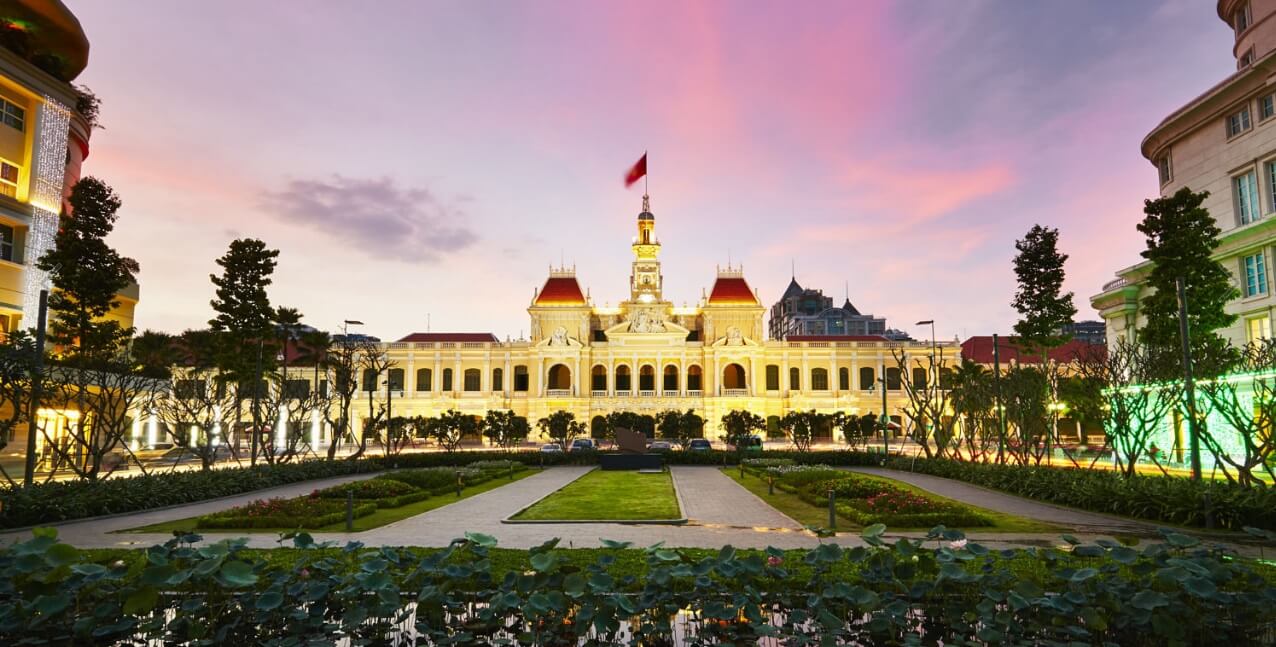
Be in the paradise, the Phu Quoc Island
Situated off Vietnam’s southernmost point, the island of Phu Quoc offers a convenient beach option for those either at the end of a Vietnam tour, or en route through the Mekong Delta into neighbouring Cambodia. Development is coming fast to Phu Quoc and new resorts are popping up all the time. Nevertheless, there are a few established properties that we recommend. Beautiful sandy beaches and clear waters greet you and set the scene for a quiet break in which to unwind in laid-back, understated comfort.

Mekong delta
It is in southern Vietnam that the Mekong River reaches the end of its 4,500 kilometre journey and splits into multiple distributaries which flow into the South China Sea. These channels give the region its Vietnamese name, Cuu Long, meaning Nine Dragons, and together form what is more commonly known as the Mekong Delta. It is one of the most agriculturally productive areas in Southeast Asia, growing rice to feed Vietnam’s entire expanding population as well as being a focus of fruit growing and fishing. At the centre of this region is the lively town of Can Tho and one of the region’s best floating markets where the people of the Delta congregate on a daily basis to sell all manner of produce and goods. Upriver is the beguiling town of Chau Doc on the Cambodian border. It is also possible to continue upriver by boat from here to Phnom Penh in Cambodia.
Click here to view Best Mekong Delta Packages
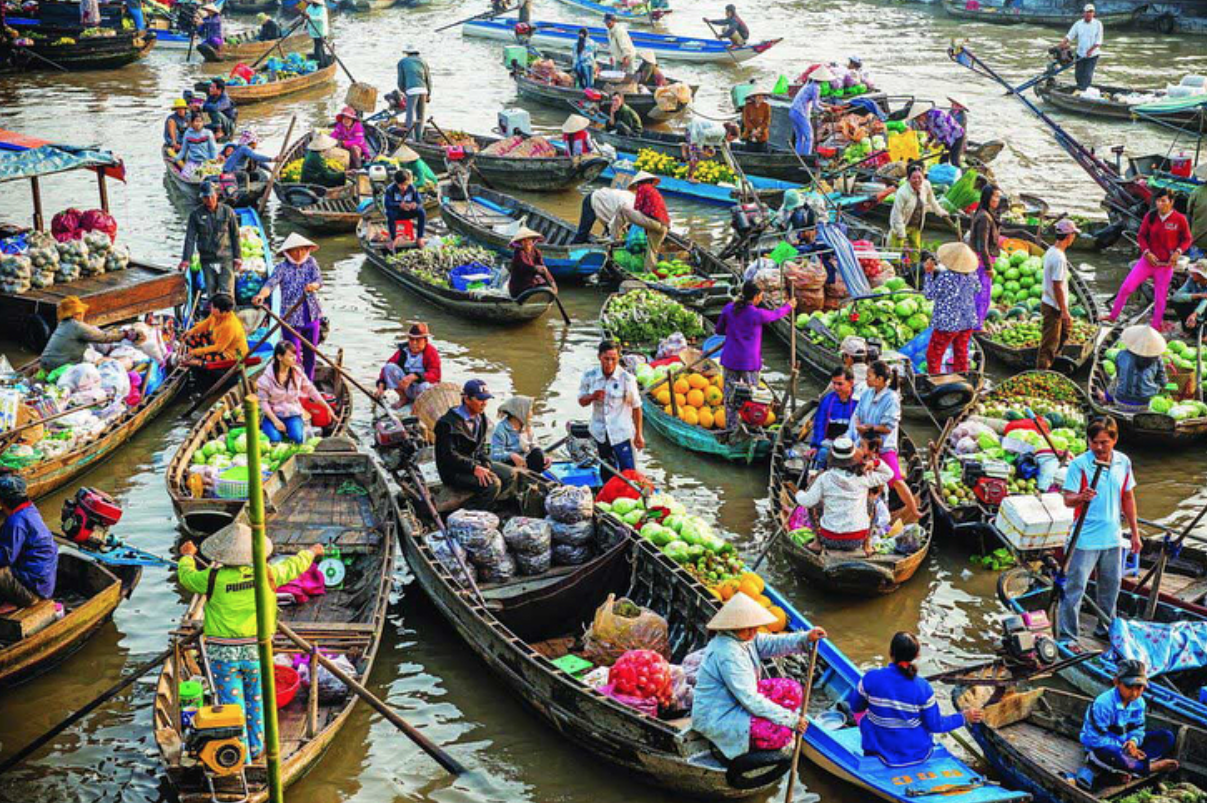
Dalat
Dalat is Vietnam’s premier hill station, established by the French to provide a cool respite from Saigon’s stifling tropical heat. With a climate of perpetual spring, the area surrounding Dalat is extremely picturesque, with tiered plateaux supporting a diverse range of crops not generally associated with Vietnam. The French influence is evident in the hundreds of colonial villas dotted throughout the town in various states of repair. Dalat is considered by many Vietnamese to be the prettiest town in Vietnam and they often choose it for their honeymoons. Everywhere you’ll see young couples taking pictures of each other against the alpine landscape of pine forests, rolling hills and tranquil lakes. After a morning of sightseeing, you can take afternoon tea and cakes on the impressive lawn of the Dalat Palace, once the centre of colonial society and a sepia-tinted reminder of days gone by.

Get excited about the landscapes of Ninh Binh
Likened to an inland Halong Bay, Ninh Binh’s charm is its limestone karst topography. The town itself is fairly unremarkable and in parts scarred by industry, but as you bypass this and head further out into the countryside, there is a chance to see an authentic rural Vietnam. With snaking rivers and farmers tending their fields with water buffaloes, the scenery around Ninh Binh is compelling and well worth taking the time to explore. You will visit impressive cave formations where local guides will gently row you through a network of waterways out into lakes dwarfed by limestone mountains. Jump on a bike and cycle along raised paths that criss-cross paddy fields or visit the remains of the ancient citadel and temples at the nearby settlement of Hoa Lu, once the capital of Vietnam. Within a two hour drive of Hanoi, it is possible to visit Ninh Binh as a day trip, but we would encourage you to stay a night or two in a comfortable hotel to fully enjoy the wide range of activities and unearth this intriguing and charming area.

Traveling around Vietnam
Renting a car with a driver and guide gives you the chance to design a travel plan the way you prefer. Seeing the country this way is almost like independent travel, except that it’s more comfortable, less time-consuming and allows for stops anywhere, or everywhere, along the way. The cost varies considerably depending what you want, where to go, where to stay and in general, where you’d like to visit. The price typically includes accommodation, a guide, a driver and a car. The itineraries shown are designed to give you a flavour of what is possible, and are routes that work particularly well. We can use these as a basis to plan your trip or can design a completely different itinerary to suit your tastes and interests. Please call one of our Vietnam specialists to start planning your itinerary.
Travel to Vietnam with motorbike
Specialized motorbike travel through Vietnam are growing in popularity. It is a great way to get off the trail and explore the mountainous regions of the north and centre of the country. Two-wheels can reach the parts that four-wheels sometimes can’t, traversing small trails and traffic-free backroads. A little experience helps, but many of leading companies also offer tuition for first-timers. Mounting a Minsk to take on the peaks of the north is one of Vietnam’s defining moments and should not be missed. Motorbike trips are based on a group of four people, you can expect to pay around US$100 per day per person for an all-inclusive tour providing motorbike rental, petrol, guide, food and accommodation.

Traveling for Work, study and volunteering in Vietnam
Vietnam’s opening up to capitalist countries has suddenly created all sorts of work opportunities for Westerners since last decade. The best-paid Westerners living in Vietnam are those working for international organisations or foreign companies, but most of these jobs are secured before arrival in the country. Foreigners who look like Rambo have occasionally been approached by Vietnamese talent scouts wanting to recruit them to work as extras in war movies.
But for most travelers the main work opportunities are teaching English in Vietnam. English is by far the most popular foreign language with Vietnamese students, but some students also want to learn French. There is also a limited demand for teachers of Japanese, German, Spanish and or Korean, or, id say, they are being popular as of 2019.
Government-run universities in Vietnam hire some foreign teachers. You will get fixed salary, but benefits such as free housing and unlimited visa renewals are usually thrown in. There is also a budding free market in private language centers and home tutoring; this is where most newly arrived foreigners seek work. Pay in the private sector is slightly better, at about US$12 to US$22 per hour, some schools offer with work-permit while most DON’T.
Finding teaching jobs is quite easy in places such as HCMC and Hanoi, and is sometimes possible in towns that have universities. Pay in the smaller towns tends to be lower and work opportunities fewer.
Places to stay in Vietnam
Vietnam has drawn on its French colonial architecture to establish a range of charming hotels, offering some of the best boutique accommodation in Indochina. These are often located in the heart of old towns, ideally placed to explore nearby restaurants and markets. All the hotels we use have been hand-picked by our staff for their location, character or individual appeal, check some offers on Vietnam all inclusive. We can also recommend homestays in the Mekong Delta and the Tonkinese Alps. The coast and islands of Vietnam are less developed than in nearby Thailand or Malaysia, yet there are a few sophisticated resorts and small, intimate properties that will suit any taste. We always strive to search out characterful alternatives to the larger hotels, as well as those that involve the local community and take efforts to protect the environment.
Copyright 2013-2017 Vietnamese Private Tours Ltd With Vietnam Luxury Travel





